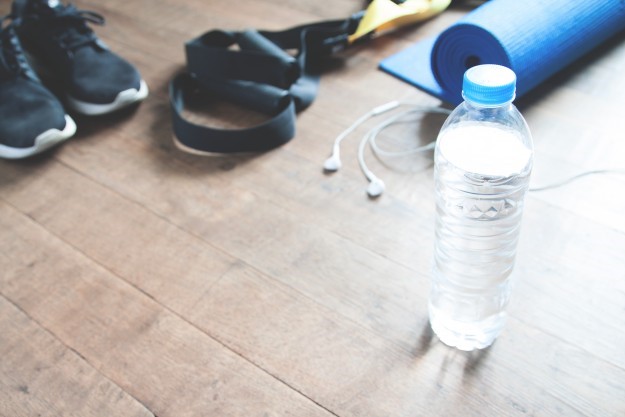
April 3, 2020, by Kate Rothery
Home work out essentials that won’t break the bank
There’s no doubt we’re all missing the gym and many of us may be stuck for ideas at home without our favourite equipment and weights. It may be tempting to invest in some fancy fitness equipment but rest assured you don’t need to spend big to meet your fitness goals.
As part of our blog series for the new online Health and Wellbeing Home, University of Nottingham Sport fitness instructors Cam and John have put together four – yes just four – simple essentials you need to work out from home.
1. Yoga mat
A yoga mat is really useful, even if you don’t practice yoga and Pilates. Mats are designed to stop your hands and feet slipping, so they make a big improvement to your grip.
A mat is ideal for balance and stretch exercises as they reduce the risk of injury. The soft spongey material also offers a better surface to land dynamic moves, like push-ups and squat jumps, more safely.
2. Water
This may seem obvious, but we can’t stress enough the importance of keeping your hydration levels up. Water helps to deliver nutrients to the working muscles, lubricates your joints and most importantly regulates your body temperature during exercise.
Your home is likely to be a lot warmer than the air-conditioned fitness suite – most people’s living rooms are around 19-20 degrees. Your body will already be warm before you start moving, so it will heat up even quicker when you start a workout. Sweating is the body’s natural way of regulating temperature, but the sweatier you get, the more water you need.
Increasing your water intake will regulate temperature and replace these lost fluids. However it also prevents nasty effects of dehydration like muscle cramps, fatigue and dizziness.
3. Weights
This is one of the questions we’re getting asked most as fitness professionals at the moment.
Picture this – you’ve been hitting the gym for a long period of time. You’ve put in the work to go from squatting your own bodyweight for 15 reps to loading your bodyweight on a barbell, placing it on your back and hitting reps for fun – and now suddenly that barbell and those weights aren’t an option to you. You’re probably thinking – do I have to go back to basics and do 100 reps in 1 set to get the same result?
The simple answer is no. Our bodies aren’t programmed to know how much weight we are lifting. Your muscles are clever enough to recruit the muscle fibers they need to lift load when placed under stress.
So, to get the same effect in the above example of the squat, we could take a few options;
Lighter resistance/ harder exercise
Like we said, our muscles don’t know how much we’re lifting so we need to find a way to challenge them without relying on more load. A common alternative to the back squat is the front squat, where the load is held in front of you – commonly referred to as a Goblet squat. The front squat is naturally harder as it places more emphasis on using the core and the range of motion is typically greater than that of a back squat. Options for loading a front squat at home could include dumbbells, a kettle bell, resistance bands, a weighted rucksack or drawstring bag.
Unilateral exercise
Another way to adapt an exercise to increase the difficulty is the stability principle. To make the squat a unilateral exercise (which is just a fancy term for using only one side of the body) you can choose from the Bulgarian split squat (with one foot on an elevated surface behind you or the Pistol squat (with one leg raised out in front of you) which is even harder.
Strength into power
Turning a strength exercise into a power exercise will naturally increase its difficulty. The body has to recruit muscle fibres at a quicker rate in order to move a typically lighter load at a much faster pace. For our example, the squat would become either a box jump (if you have something high enough and safe enough to land on) or a squat jump. It is worth noting that power training is inherently different to strength training, but for the purpose of increasing difficulty it works well.
4. Music
Don’t forget about music – it can really make your workout. Either you’re the kind of person who needs your favourite music blasting or you prefer the peace and quiet – generally we find there’s not much in between! However, we really believe the one with the tunes on would perform better to their personal ability.
Music actually has an ergogenic effect on physical performance. Studies have shown that listening to music during exercise can decrease your perception of exertion – how hard the exercise feels (remember the RPE scale from our Home Workout Plan blog). So you’ll actually find you have better than expected levels of endurance, power, productivity and strength, usually through either delaying fatigue or increasing work capacity.
If you’re stuck for inspiration, why not try the University of Nottingham Sport playlists on Spotify? We’ve got a brand new #NoGymNoProblem playlist chosen by our staff and students that’s perfect!
No comments yet, fill out a comment to be the first

Leave a Reply